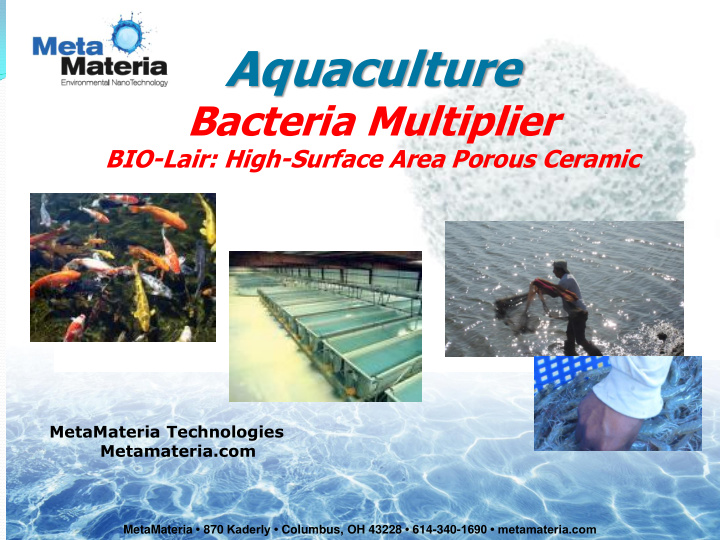



Aquaculture Bacteria Multiplier BIO-Lair: High-Surface Area Porous Ceramic MetaMateria Technologies Metamateria.com 1 MetaMateria • 870 Kaderly • Columbus, OH 43228 • 614-340- 1690 • metamateria.com
BIO Media Products Very Effective Bacteria Multiplier High Surface Area = More Bacteria More surface than other substrates 7 times more bacteria in water Over 2,000,000 m 2 /m 3 of surface area or 8,100 m 3 /Kg of media Comparision Pentair - Aquatic Ecosystems Catalog Ship Weight 1 Kg BIO 1/4 Kg BIO M 2 / M 3 M 2 / Kg Kg Needed Product Description Kg Spiorax porous ceramic 268,990 0.5 21 14 3.5 BIO-FILL shredded PVC ribbon 820 1.8 13 640 160.0 BIO-BALL Plastic Ball Shape 321 5.4 2 4898 1224 BIO-BARREL Polyproplene open barrel 210 2.7 2 3750 938 BIO-STRATA Black PVC sheets in block form 361 2.3 18 455 114 Meta BIO Media BIO - porous ceramic (Ca,DN) 2,296,257 6.8 8,192 1.7 2,048 2 MetaMateria • 870 Kaderly • Columbus, OH 43228 • 614-340- 1690 • metamateria.com
Aquaculture Plays Key Role in Supplying Food in World Over 158 million Tonnes of Fish, Shrimp, etc. Consumed 84% Raised in Asia – Mostly in China (>60%) Growing Economic Production Needed to Meet Demand Disease Threatens Growth – Healthier Water Needed Improve the water and creatures grow faster, are healthier, and less food is wasted More Bacteria Grow on BIO-Lair Media 3
Aquaculture Enhance Nature’s way to remove wastes (Microorganism are natures original recycler) For high density aquaculture Improved ways to control water quality needed Major Wastes Residual food and fecal matter Metabolic by-products Residues of biocides and biostats Wastes produced during moulting Collapsing algal booms Bioremediation – when micro and macro living organism are used to maintain water quality Bacterial flocs are also consumed by fish
Aquaculture Successful Bioremediation Keep Ammonia & Nitrite low (below 0.5 mg/L) Enhance denitrification to convert nitrate to nitrogen gas Maximize sulfide oxidation to reduce H2S accumulation Maximize carbon oxidation to CO2, to minimize sludge Improve productivity (faster growth, lower mortality) – with improved water quality Fight diseases – lower use of antibiotics – use probiotics Control undesirable species .
Working Together Special Aquaculture Blends of Bacteria provide proven microbial and probiotic water treatment Strong, Fast Growing Bacteria Lowers Ammonia Enzymatic Bacteria Break Down Proteins, Oils, Organics Probiotic Bacteria Strengthen Digestive Track of Fish & Shrimp to Fight Diseases BIO-Lair Bacteria Multiplier BIO-Lair Porous Ceramics Sustains High Concentration of Bacteria Colonies. Increases Bacteria Concentration by 5 times and more BIO-Lair speeds up Nature’s way for removing waste products from water without chemicals 6 MetaMateria • 870 Kaderly • Columbus, OH 43228 • 614-340- 1690 • metamateria.com
Why Does This Work Bacteria Blends Designed for Aquaculture Active Colonizable Units (>100 million CFU) Environmentally Safe Formula Enzymes to catalyze breakdown complex organics Probiotic Bacteria to help fight diseases High Surface Area of Media – Over 8,000 m 3 /Kg 1 Kg has surface equal to 700 Kg of plastic media Sustains bacteria in the water above 15,000 mg/L 6 times higher than norm of 2,500 mg/L Holds weight in water – protects bacteria out of water Only 15-25 Kilo per Hectare needed 7
Bioremediation of Carbonaceous Waste Microbes that multiply rapidly and have good enzymatic capability Members of genus Bacillus and Phenibacillus Produces variety of enzymes that break down protein and starch to small molecules, which are taken up as energy sources by other organisms Higher amounts not normally present in water column – natural habitat is in sediment Bio-Lair provides huge surface for microbes to grow rapidly and increases their presence in water columns significantly Competes with bacterial flora naturally presents – out completes and removes cyanobacteria (blue green algae) Reduces water turbidity and reduces use of mechanical filtration and water change.
Removal of Nitrogenous Compounds Bio-Lair provides simultaneous oxidation of ammonia and nitrites and reduce nitrates in Anaerobic Zones created inside Bio-Lair while Aerobic Zones exist near the product surface. • Ammonia Sources • Fish excretion • Mineralization of organics • From reduced sentiment • Ammonia oxidizers – Nitrpsomonas, Nitrovibrio, Nitrococus,Nitrobus and Nitrospira • Nitrite oxidizers – Nitrobacter, Nitococcus and Nitrosphra • Nitrate reducers – Pseudomonas, Bacillus and Alkaligenes • Bacteria need substrates for high bacteria density growth
BIO-Lair Substrates for Nitrifiers Nitrifiers can survive and grow in water without attachment to a solid surface High surface area of Bio-Lair media promotes the highest density of nitrifiers. Bacteria will thrive and proliferate due to aggregation on solid surfaces available Inorganic ions are attracted to the surface of bio-films and surfaces of the media promoting greater nitrification rates and improved water quality
Synergy of Combination of Bio-Lair & Bacteria Faster Growth of fish or shrimp – more kilo’s/cycle Higher Yields per liter of water – more kilos produced Lower Feed conversion ratios – reduces cost for high protein feed and need for medicated feed Healthy Water – Less Stress of Creatures & fewer pollutants to affect Water Quality or Growth Rate Quick Payback of investment – make more money on any basis. Payback can occur in 1-2 growing cycles 11
Control Harmful Algae Blooms Cyanobacteria Blooms Cause Problems Microcystin toxins excreted - harmful to humans and animals Flavor in fish and shrimp affected by excreted contaminants Eutrophication – lowers oxygen in water – fish die Nutrients too High - particularly phosphorus Reduce Cyanobacteria with Bacteria Breakdown Cyanobacteria Filaments with Bacteria Sustain Bacteria Concentrations to prevent forming High Bacteria lowers phosphorus in water 12
Recommend
More recommend